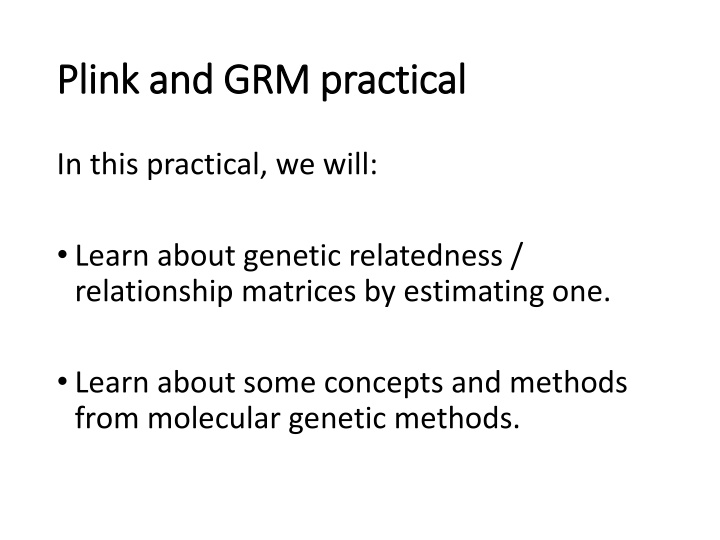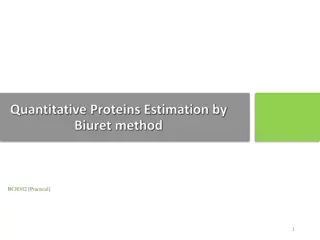
Learn Genetic Relatedness Estimation and Molecular Methods
Explore genetic relatedness matrices, molecular genetic methods, and practical steps using PLINK software in this hands-on tutorial. Learn about simulated datasets, file formats, data cleaning, and estimating genetic relatedness matrices for analyzing genetic data.
Download Presentation

Please find below an Image/Link to download the presentation.
The content on the website is provided AS IS for your information and personal use only. It may not be sold, licensed, or shared on other websites without obtaining consent from the author. If you encounter any issues during the download, it is possible that the publisher has removed the file from their server.
You are allowed to download the files provided on this website for personal or commercial use, subject to the condition that they are used lawfully. All files are the property of their respective owners.
The content on the website is provided AS IS for your information and personal use only. It may not be sold, licensed, or shared on other websites without obtaining consent from the author.
E N D
Presentation Transcript
Plink and GRM practical Plink and GRM practical In this practical, we will: Learn about genetic relatedness / relationship matrices by estimating one. Learn about some concepts and methods from molecular genetic methods.
Our data Our data Simulated dataset based on real data.
gwas_plinkdata.ped 150 individuals 23 MZ pairs, 21 DZ pairs, 62 unrelated individuals
1) Change working directory 1) Change working directory First, open Unix terminal. Copy the files to a folder of your preference. Then, we need to make sure we are working in the right folder: cd C:/Users/joseMor/Documents
2) Check 2) Check file file format format PLINK-friendly formats (.bed and .ped): PED: pedigree information standard BED: compressed (binary) version of PED plink --file gwas_plinkdata --make-bed --out gwas_plinkdata
3) Clean the data (quality 3) Clean the data (quality control) control) PLINK includes several options to clean genetic data. This means filtering out low quality data or outliers. We are going to run a very basic quality control (to learn more: next year at the IBG GWAS workshop!) plink --bfile gwas_plinkdata --geno 0.05 --mind 0.05 --hwe 1e-6 --maf 0.1 --make-bed --out gwas_plinkdata_clean
4) Estimate the 4) Estimate the genetic relatedness matrix genetic relatedness matrix Output style (A) -- matrix plink --bfile gwas_plinkdata_clean --make-rel triangle Take a look to the results in Unix zless -S plink.rel
4) Estimate the 4) Estimate the genetic relatedness matrix genetic relatedness matrix Open the file GRM_highlighted.pdf to see how it looks. Zoom in to find which individuals are likely to be MZ twins (in green), DZ twins (in red), and genetically unrelated (not highlighted).
4) Estimate the 4) Estimate the genetic relatedness matrix genetic relatedness matrix
4) Estimate the 4) Estimate the genetic relatedness matrix genetic relatedness matrix Output style (B) relatedness pair by pair plink --bfile gwas_plinkdata_clean -make-grm- gz no-gz Take a look to the results in Unix zless -S plink.grm
4) Estimate the 4) Estimate the genetic relatedness matrix genetic relatedness matrix Open the file grel_highlighted.xls to see how it looks. You can sort the data by gen. relatedness and find which pairs are likely to be MZ twins (in green), DZ twins (in red), or unrelated individuals (not highlighted).
4) Estimate the genetic relatedness matrix 4) Estimate the genetic relatedness matrix ID1 2 3 3 4 26 73 ID2 1 1 2 1 3 51 common SNPs 247262 250987 247011 247683 251499 247061 gen relatedness -0.0233 -0.0227 -0.0209 -0.0195 0.9960 0.5048






















